Submitted:
23 October 2023
Posted:
23 October 2023
You are already at the latest version
Abstract
Keywords:
1. Introduction
2. GaN HEMT Based Class E Resonant Wireless Power Transfer
2.1. Power Transmitting Unit (PTU)
2.2. Power Receiving Unit (PRU)
2.3. Transformer Model for WPT
2.4. GaN HEMT Module
2.5. Subharmonic Oscillation
3. PRU Module for Battery Charging
3.1. AC-DC Converter
3.2. Resonant Capacitive Voltage Divider
3.3. Battery Charger Using a Flat-band Band-Pass Filter
3.4. Magnetic Coupling Coefficient
4. Simulation and Experiment
4.1. Simulation
4.2. Experiment
5. Conclusions
Funding
Institutional Review Board Statement
Informed Consent Statement
Data Availability Statement
Acknowledgments
Conflicts of Interest
References
- Zhang, Z., Pang, H., Georgiadis, A., Cecati, C. Wireless power transfer—An overview. IEEE transactions on industrial electronics, 66(2), 2018, pp. 1044–1058. [CrossRef]
- Mahesh, A., Chokkalingam, B., Mihet-Popa, L. Inductive wireless power transfer charging for electric vehicles–a review. IEEE Access, 9, 2021, 137667-137713. [CrossRef]
- Green, P. B. Class-E power amplifier design for wireless power transfer. August 2018. Rev 1.2. Infineon, Appl. Note 1803, pp. 1–51. Available online: infineon.com (accessed on August 2018).
- Paolucci, M.; Green, P. B. Benefits of GaN e-mode HEMTs in wireless power transfer - GaN power devices in resonant class D and class E radio frequency power amplifiers. October 2018. Rev 1.0. Infineon, White Paper. Available online: infineon.com (accessed on October 2018).
- Choi, J., Tsukiyama, D., Tsuruda, Y., Davila, J. M. R. High-frequency, high-power resonant inverter with eGaN FET for wireless power transfer. IEEE Transactions on Power Electronics, 33(3), 2017, pp. 1890–1896. [CrossRef]
- Sinha, S., Regensburger, B., Kumar, A., Afridi, K. A very-high-power-transfer-density GaN-based capacitive wireless power transfer system. In 2017 IEEE 5th workshop on wide bandgap power devices and applications (WiPDA), 2017, pp. 360-365.
- Abou Houran, M.; Yang, X.; Chen, W. Free Angular-Positioning Wireless Power Transfer Using a Spherical Joint. Energies 2018, 11, 3488. [CrossRef]
- F. Jolani, Y. -q. Yu and Z. Chen, "A planar positioning-free magnetically-coupled resonant wireless power transfer," 2015 IEEE Wireless Power Transfer Conference (WPTC), Boulder, CO, USA, 2015, pp. 1-3. [CrossRef]
- Liu, C.-Y.; Wu, C.-C.; Tang, L.-C.; Shieh, Y.-T.; Chieng, W.-H.; Chang, E.-Y. Resonant Mechanism for a Long-Distance Wireless Power Transfer Using Class E PA and GaN HEMT. Energies 2023, 16, 3657. [CrossRef]
- Larky, A. Negative-impedance converters. IRE Transactions on Circuit Theory, 4(3), 1957, pp.124–131.
- Yoon, S. H., Kim, T. H., Yook, J. G., Yun, G. H., Lee, W. Y. High Q-factor WPT system with negative impedance converter. In 2017 IEEE Wireless Power Transfer Conference (WPTC), 2017, pp. 1–4).
- Kim, T. H., Yun, G. H., Lee, W., Yook, J. G. Highly efficient WPT system with negative impedance converter for Q-factor improvement. IEEE Access, 7, 2019, 108750–108760. [CrossRef]
- Liu, Y.; Li, B.; Huang, M.; Chen, Z.; Zhang, X. An Overview of Regulation Topologies in Resonant Wireless Power Transfer Systems for Consumer Electronics or Bio-Implants. Energies 2018, 11, 1737. [CrossRef]
- E. Abramov, Y. Schultz, M. Evzelman, and M. M. Peretz, “Analysis and design of post-regulation stages for resonant capacitively-coupled wireless power systems,” in Proc. IEEE Appl. Power Electron. Conf. Expo., 2022, pp. 492–499.
- Harmonic and Subharmonic Oscillations. Available online: https://phys.libretexts.org/Bookshelves/Classical_Mechanics/Essential_Graduate_Physics_-_Classical_Mechanics_(Likharev)/05%3A_Oscillations/5.08%3A_Harmonic_and_Subharmonic_Oscillations.
- Weng, Y.-C.; Wu, C.-C.; Chang, E.Y.; Chieng, W.-H. Minimum Power Input Control for Class-E Amplifier Using Depletion-Mode Gallium Nitride High Electron Mobility Transistor. Energies 2021, 14, 2302. [CrossRef]
- Liu, C.-Y.; Wang, G.-B.; Wu, C.-C.; Chang, E.Y.; Cheng, S.; Chieng, W.-H. Derivation of the Resonance Mechanism for Wireless Power Transfer Using Class-E Amplifier. Energies 2021, 14, 632. [CrossRef]
- Hayashi, C. Subharmonic oscillations in nonlinear systems. Journal of Applied Physics, 24(5), 1953, pp. 521–529.
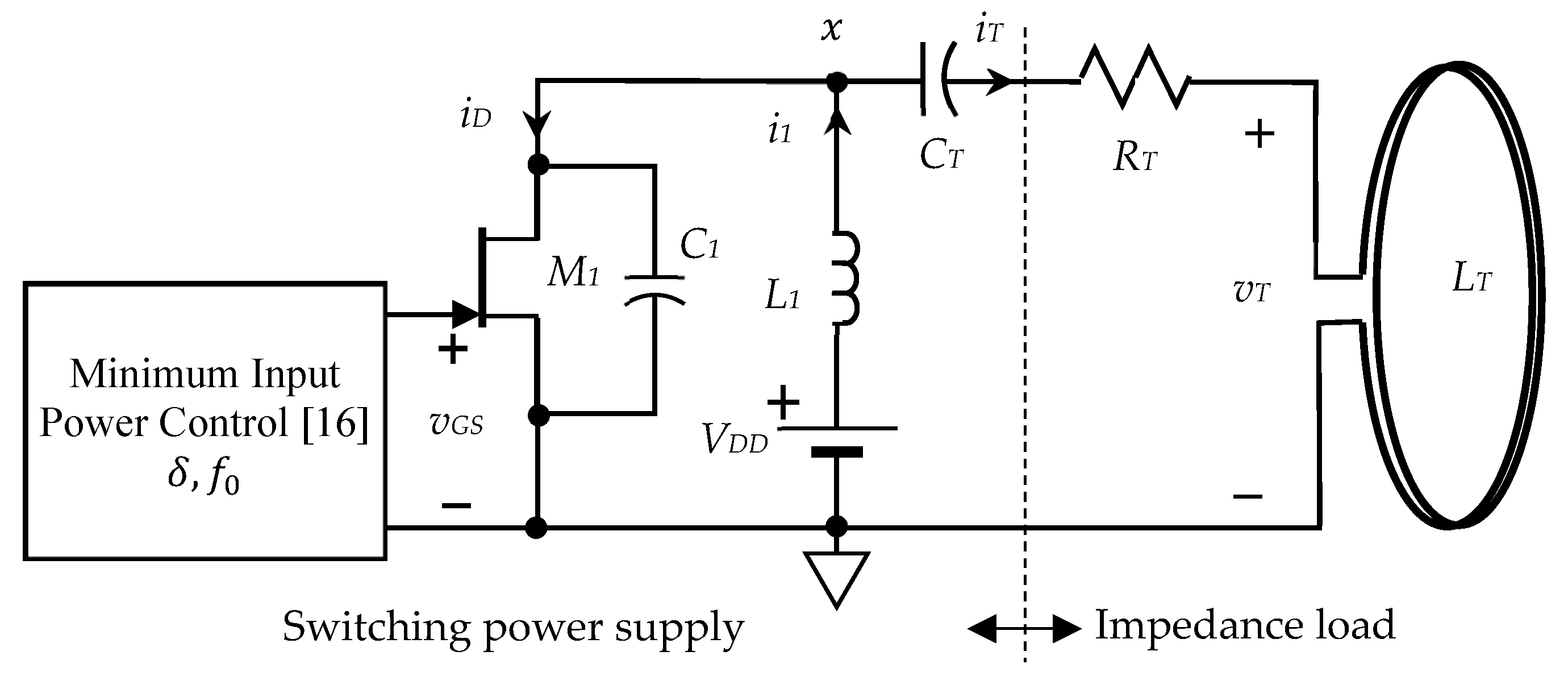
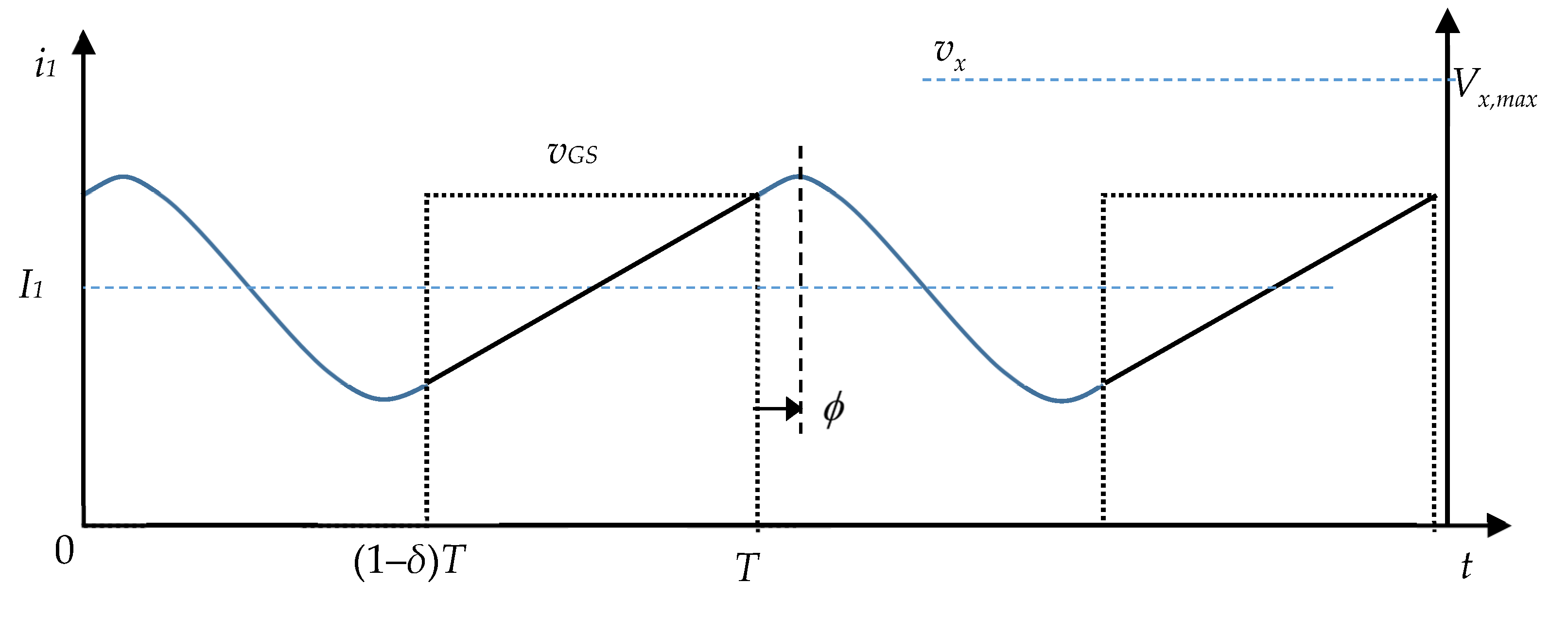
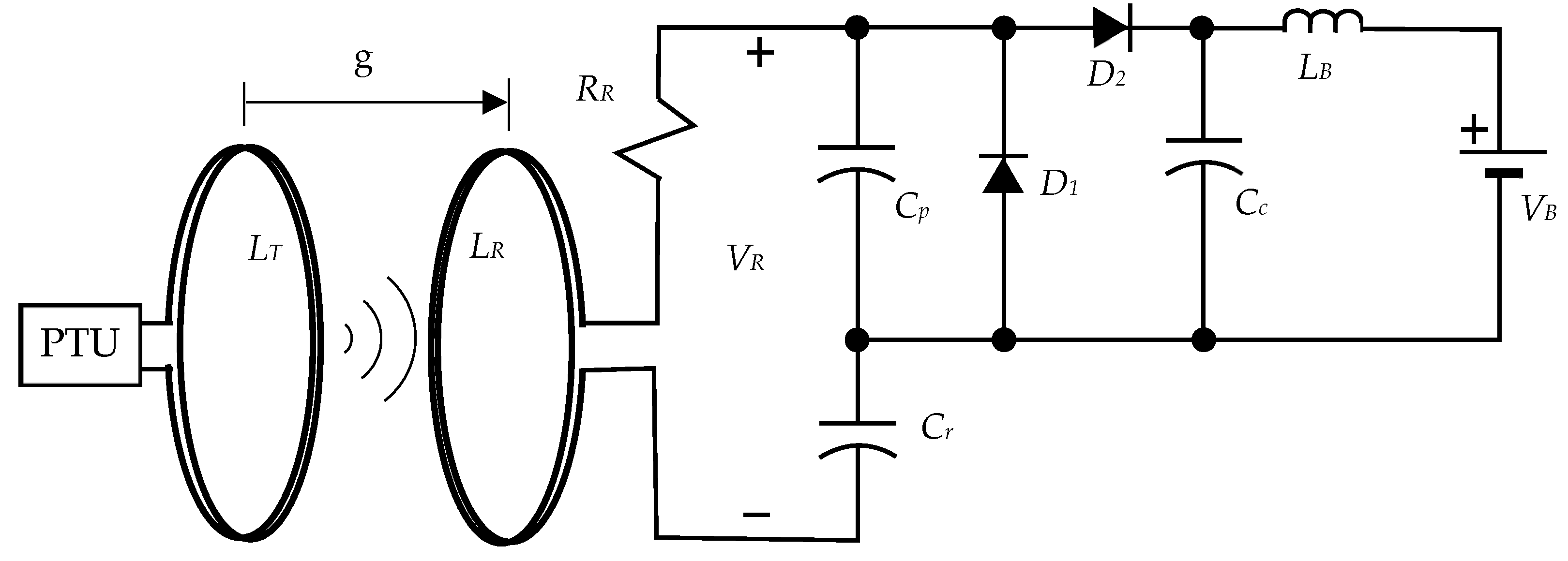
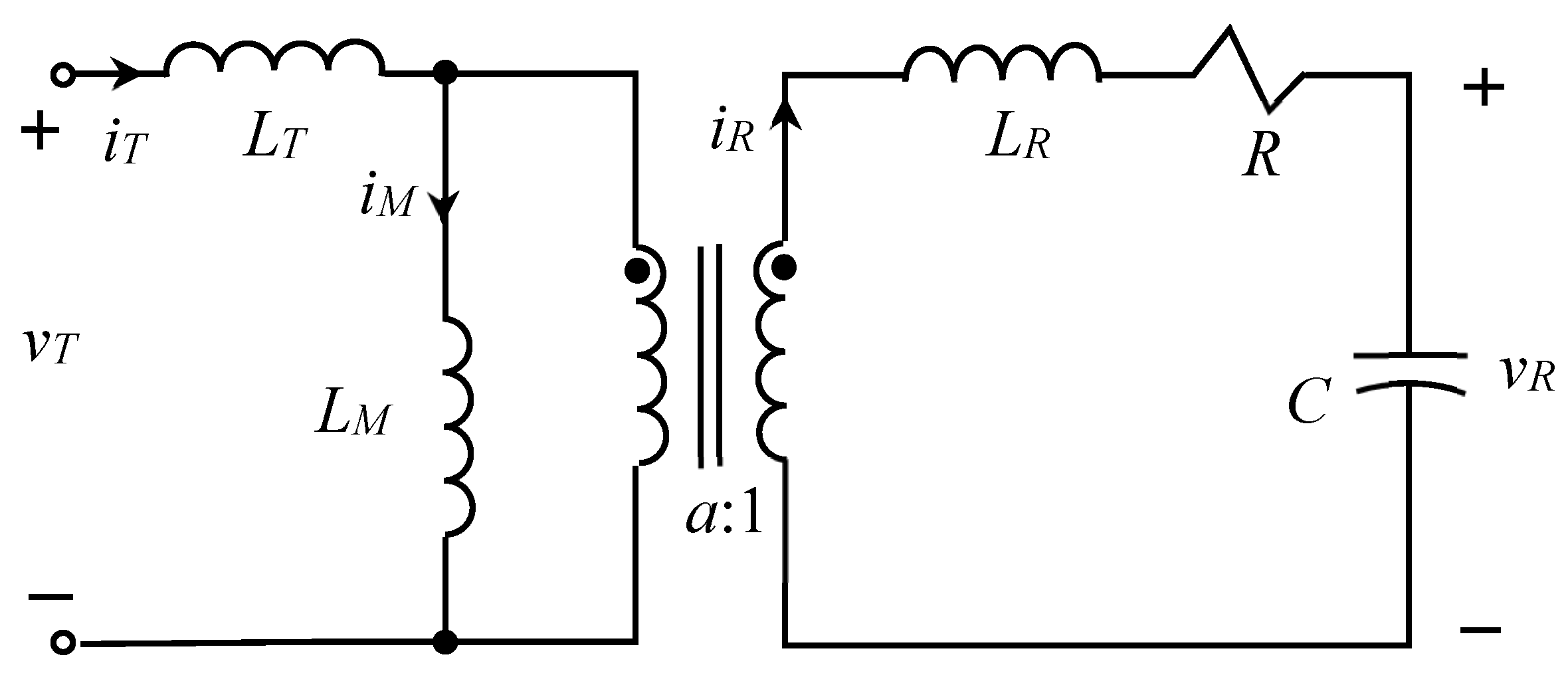
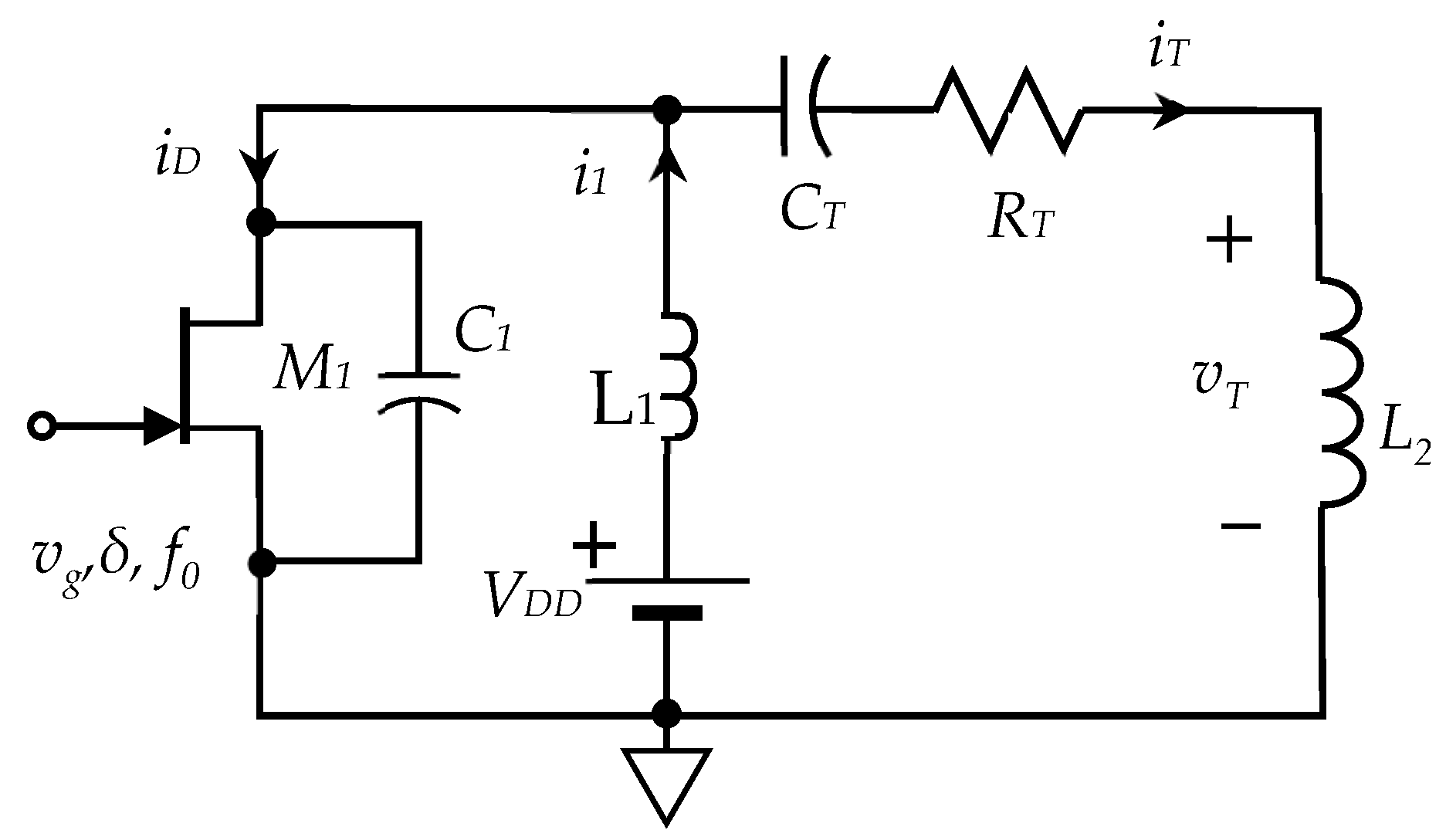
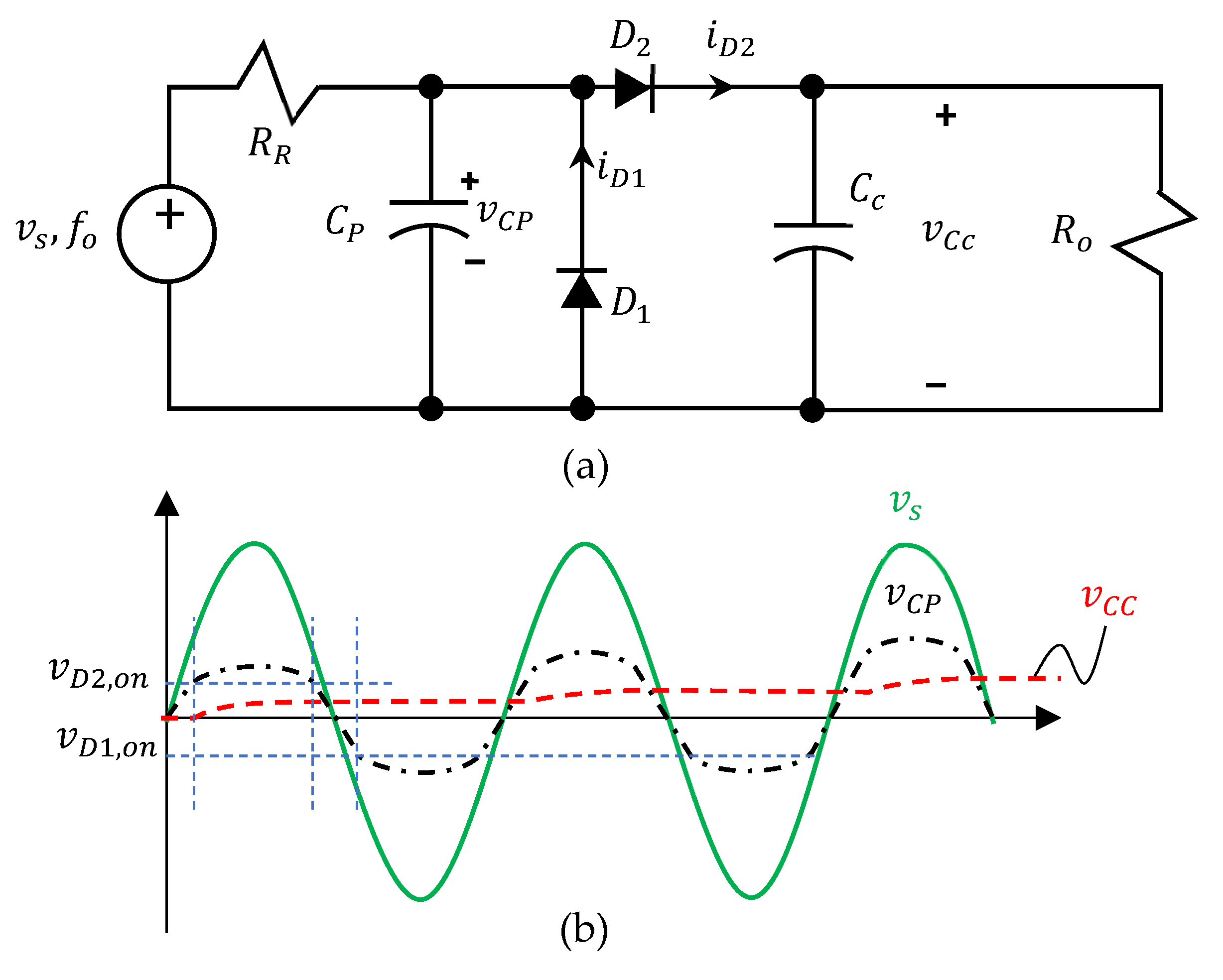
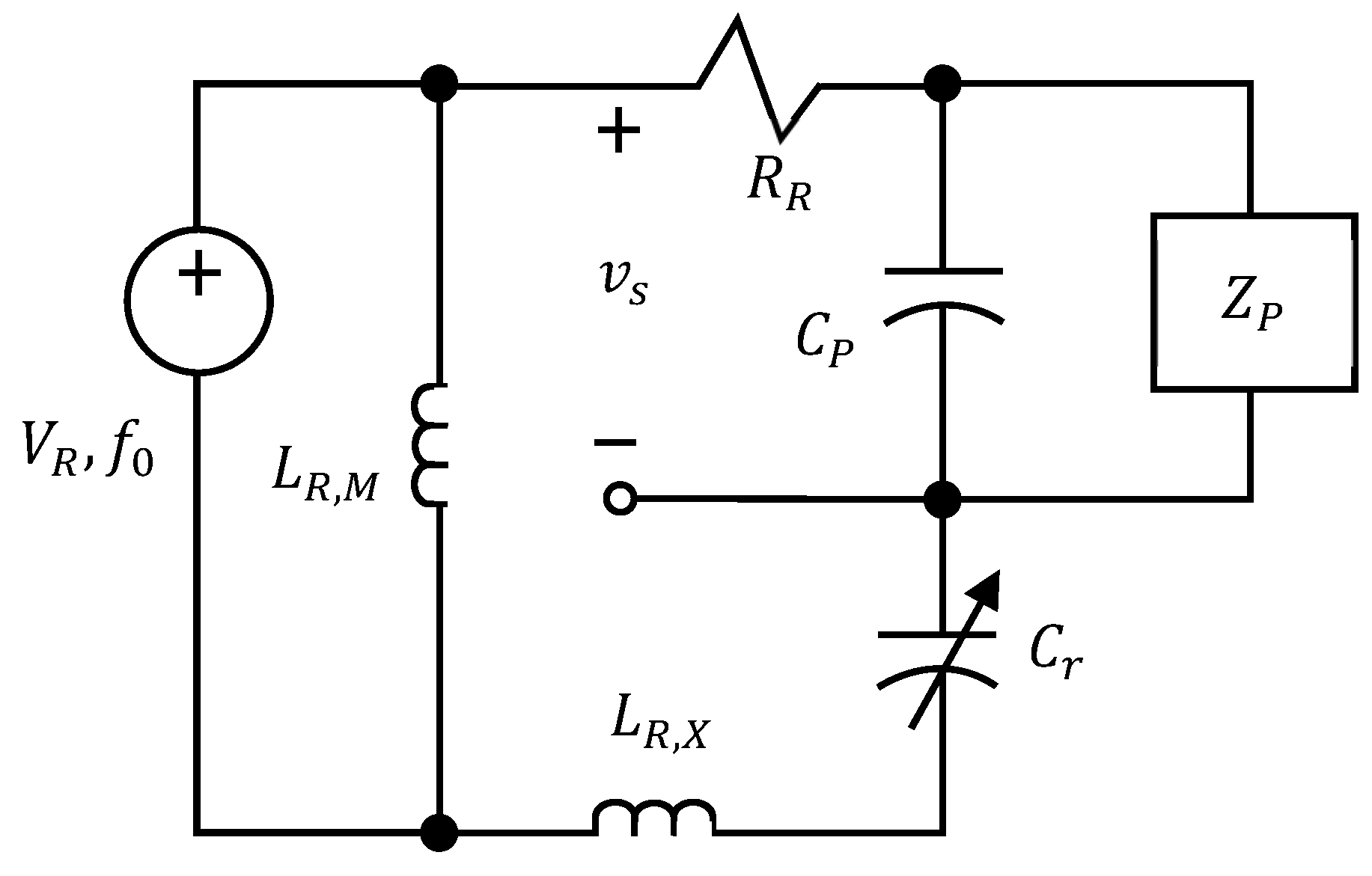
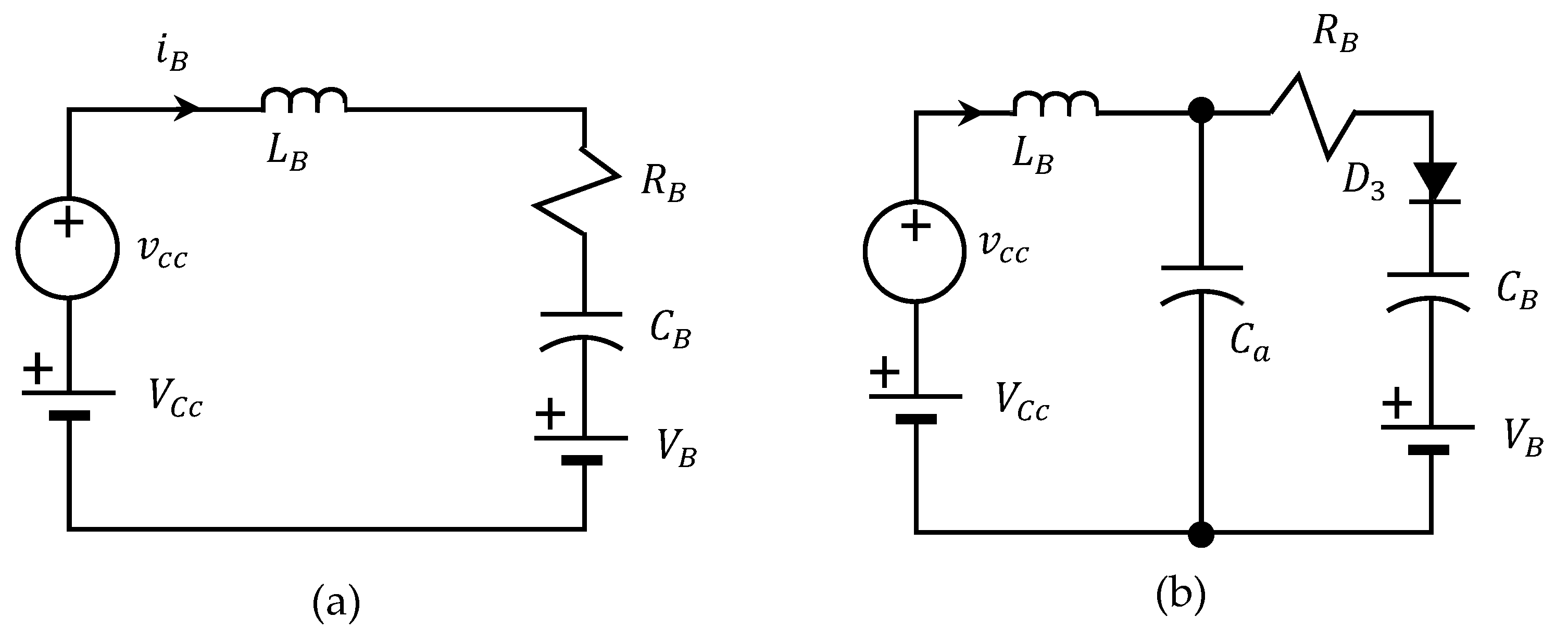
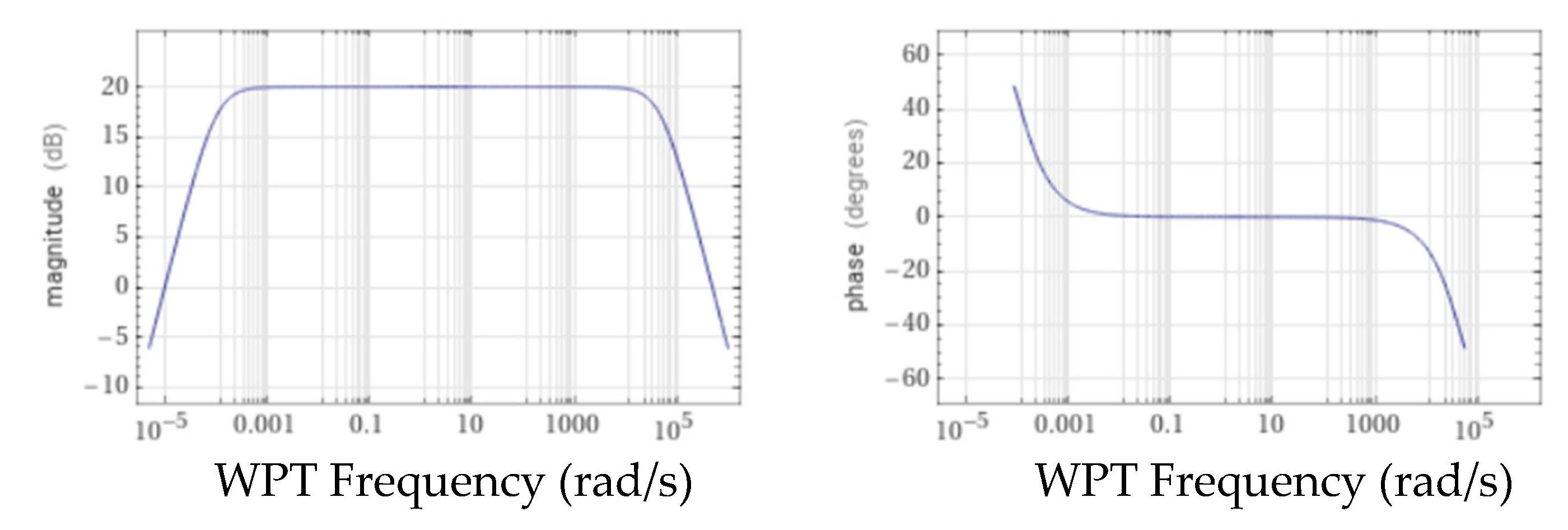
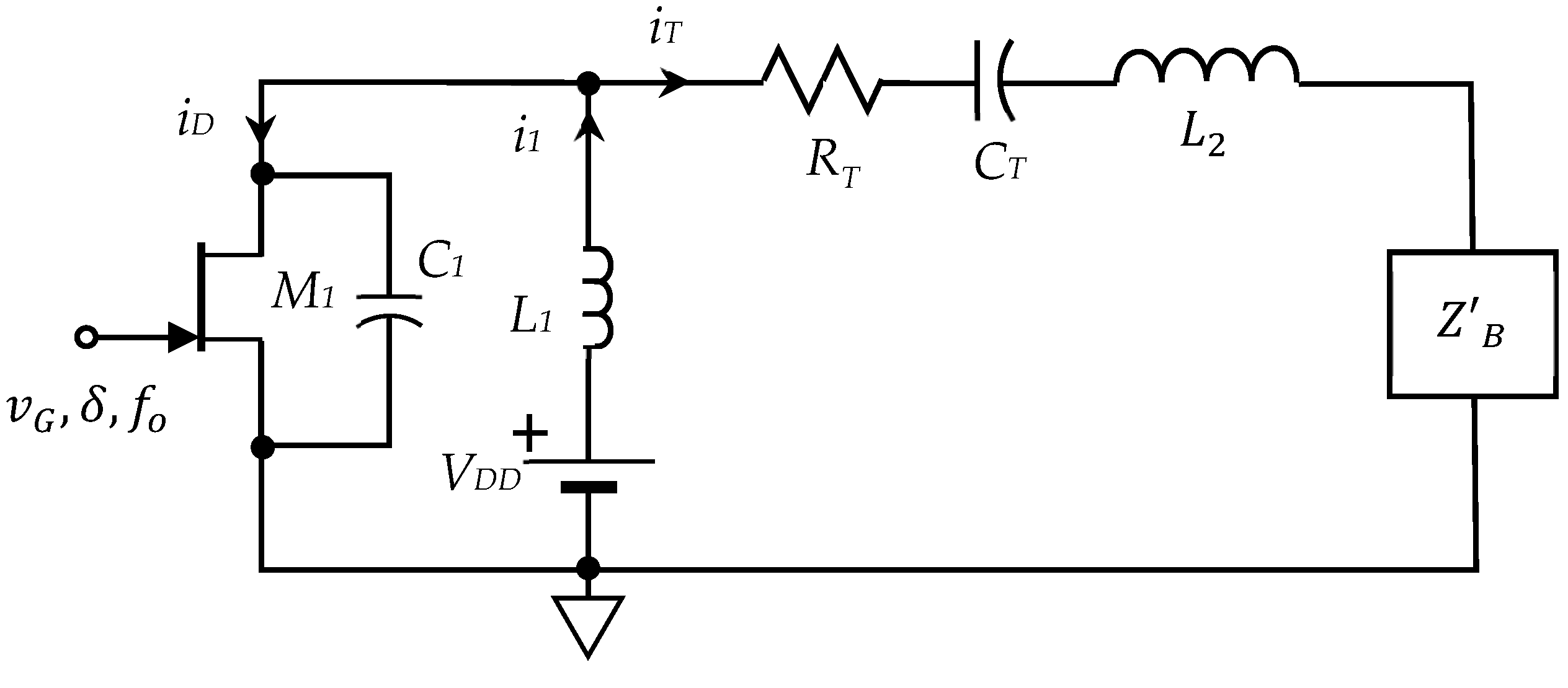
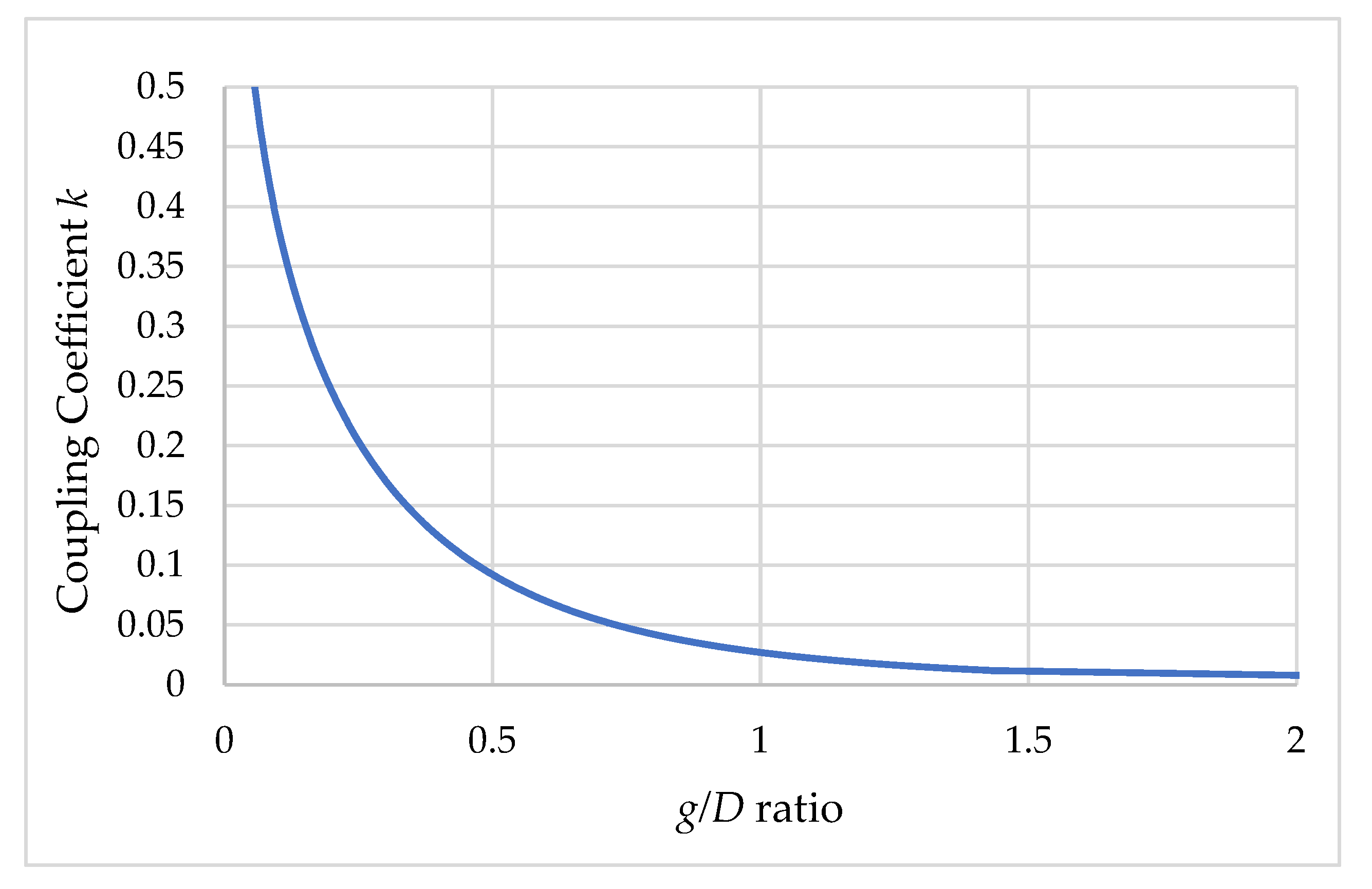
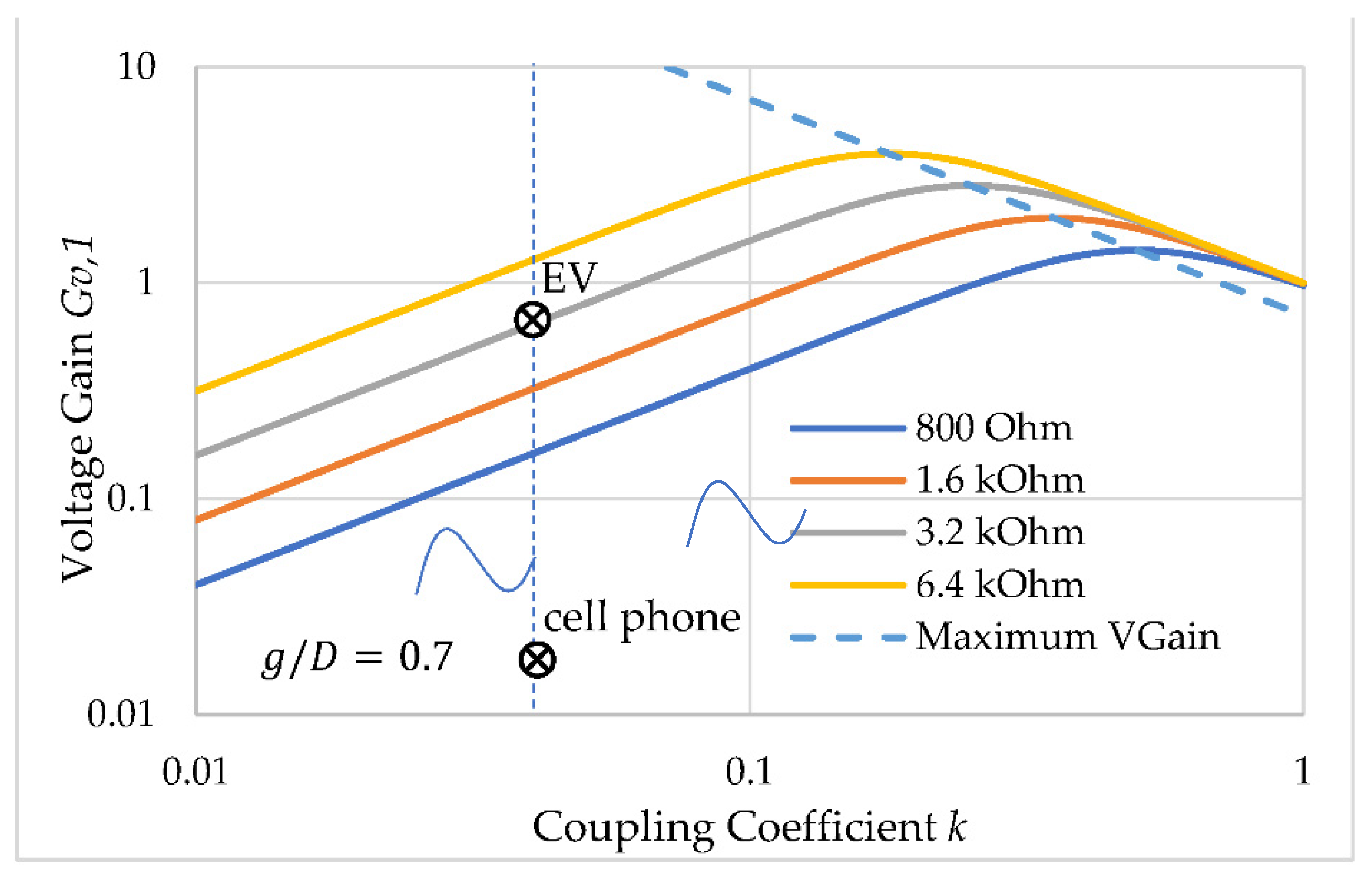
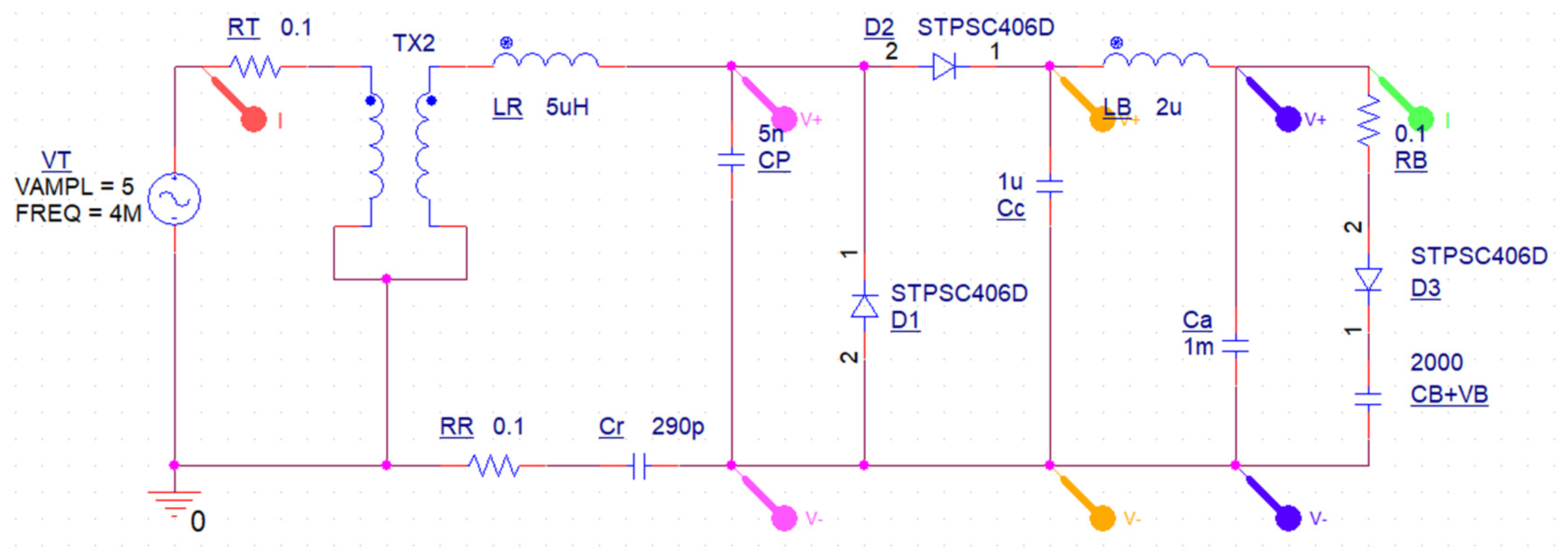
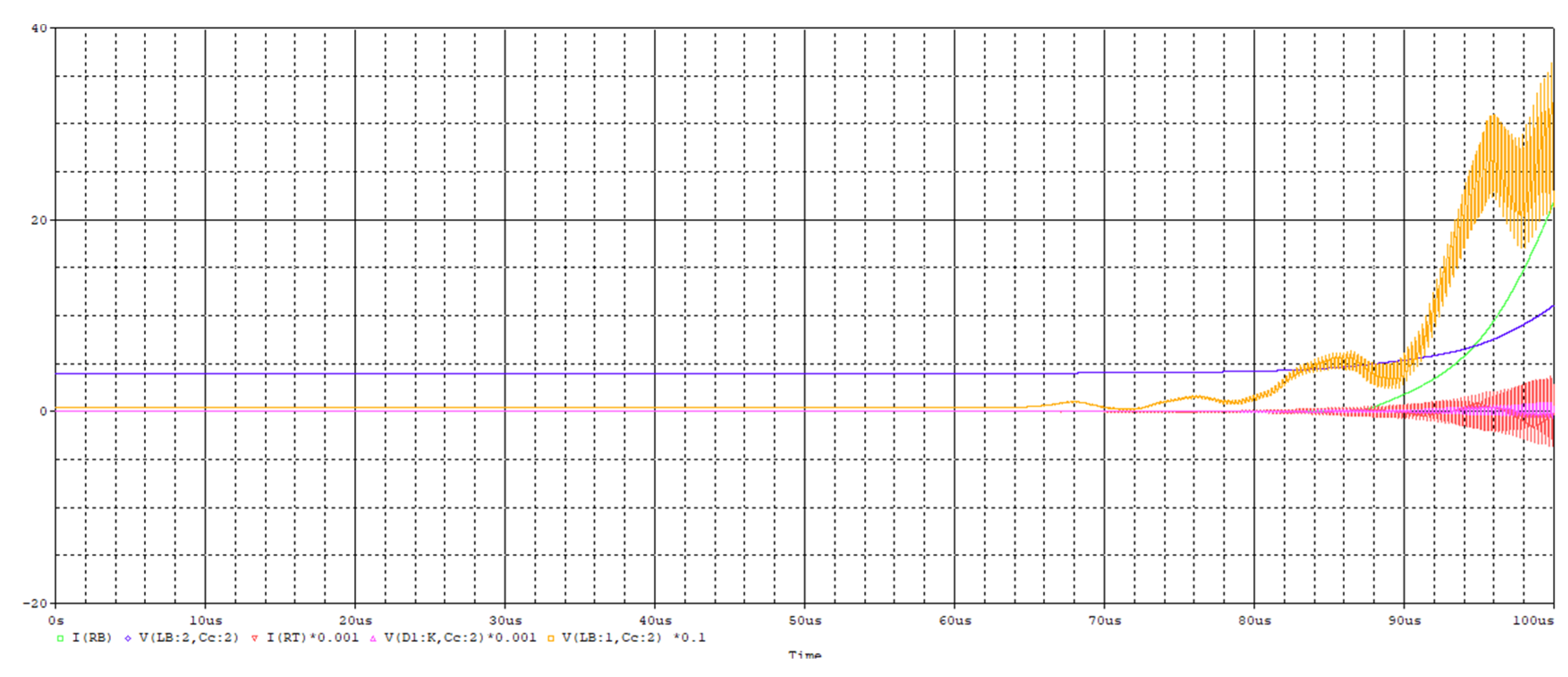
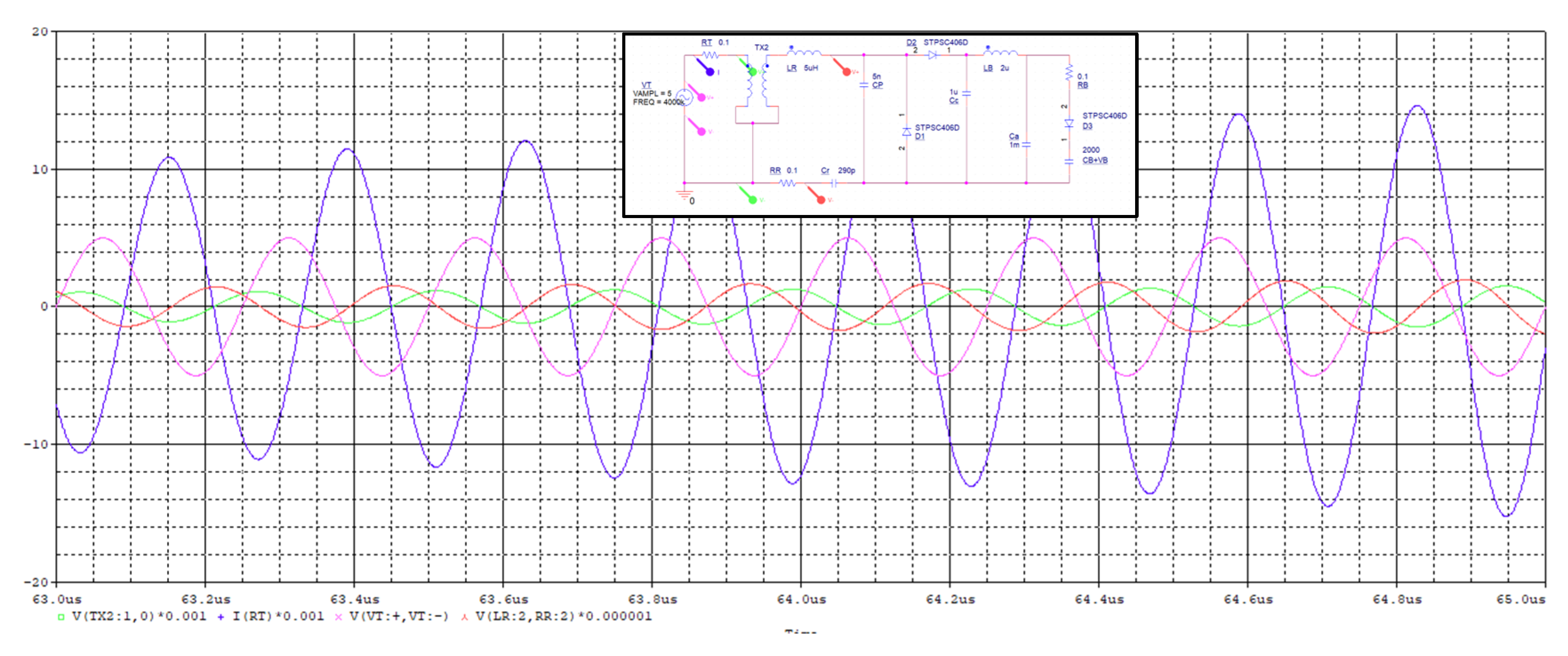
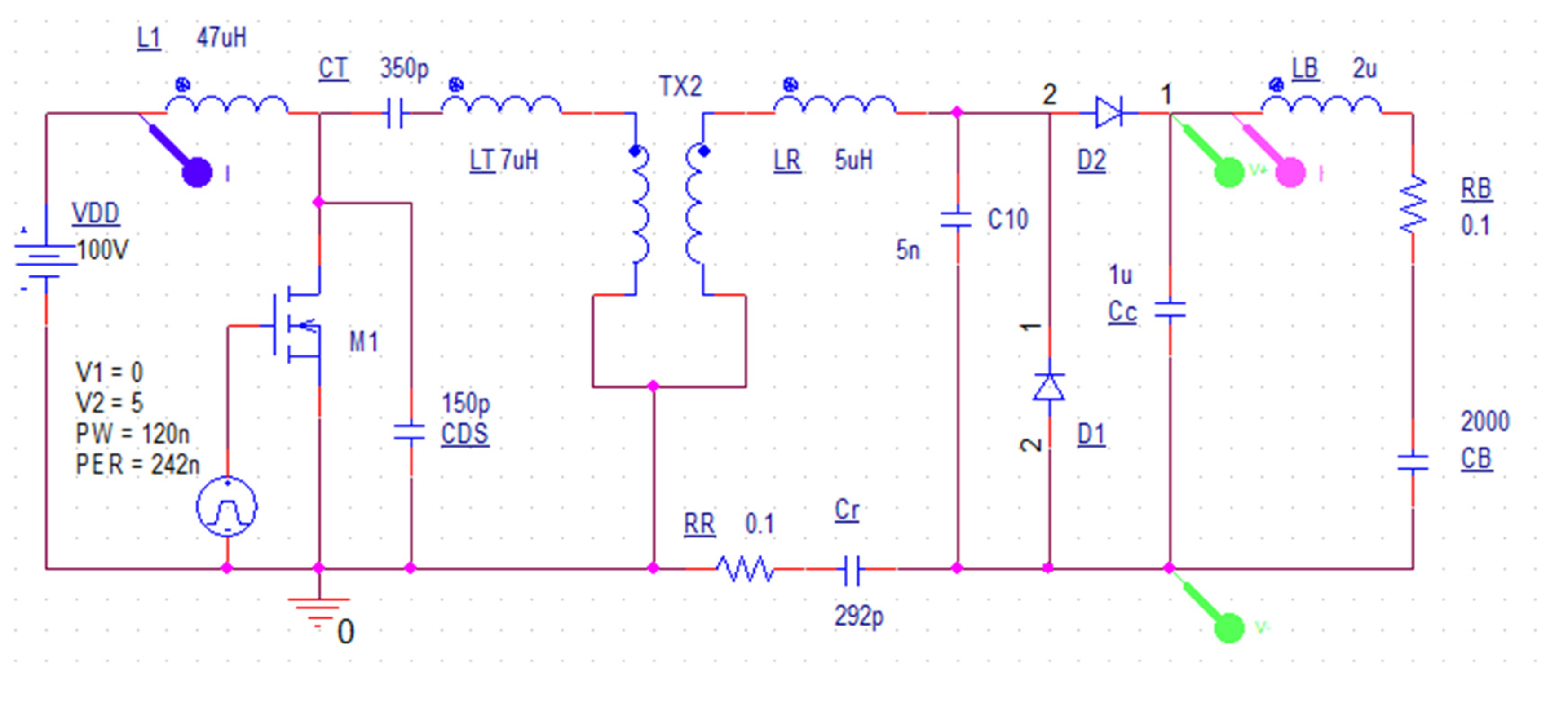
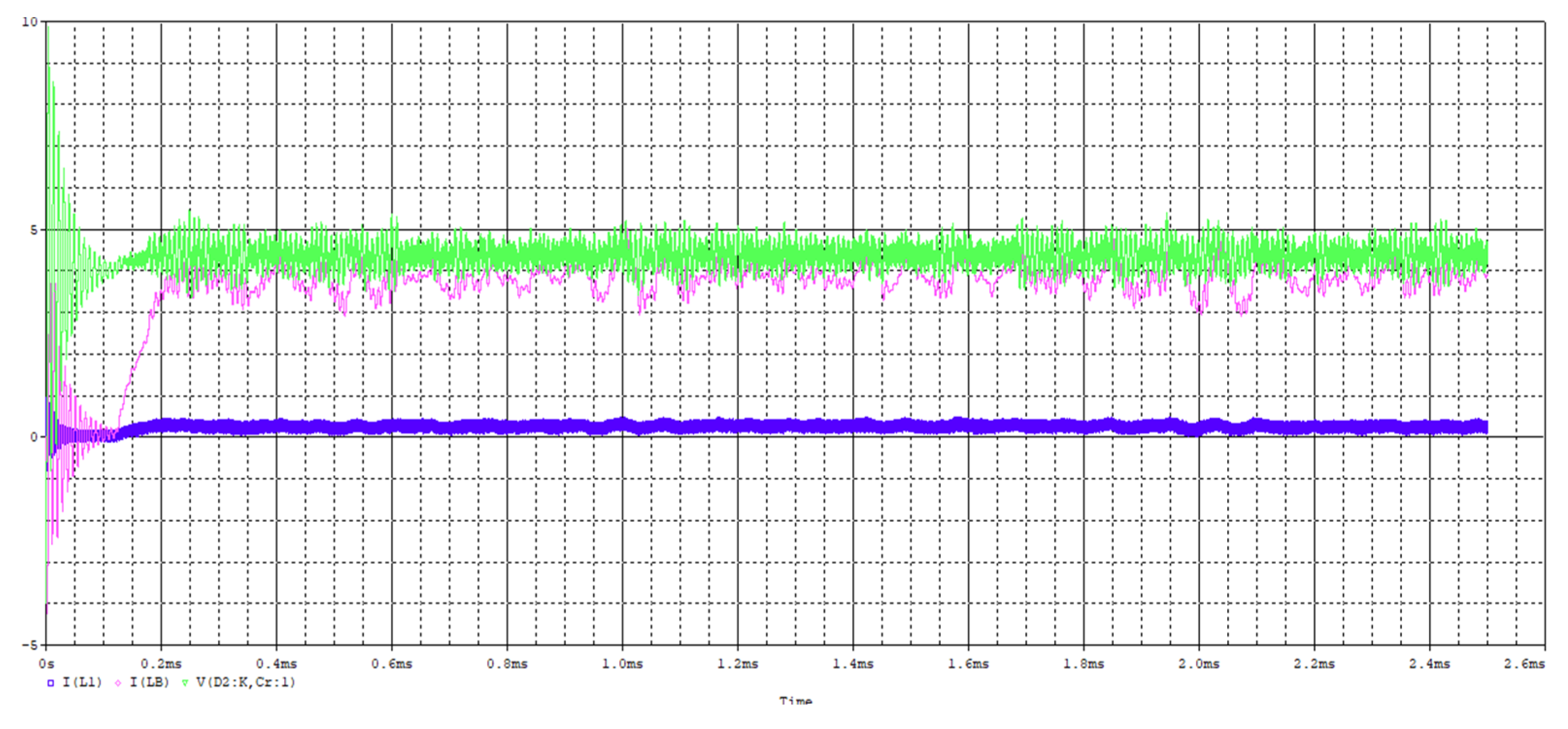
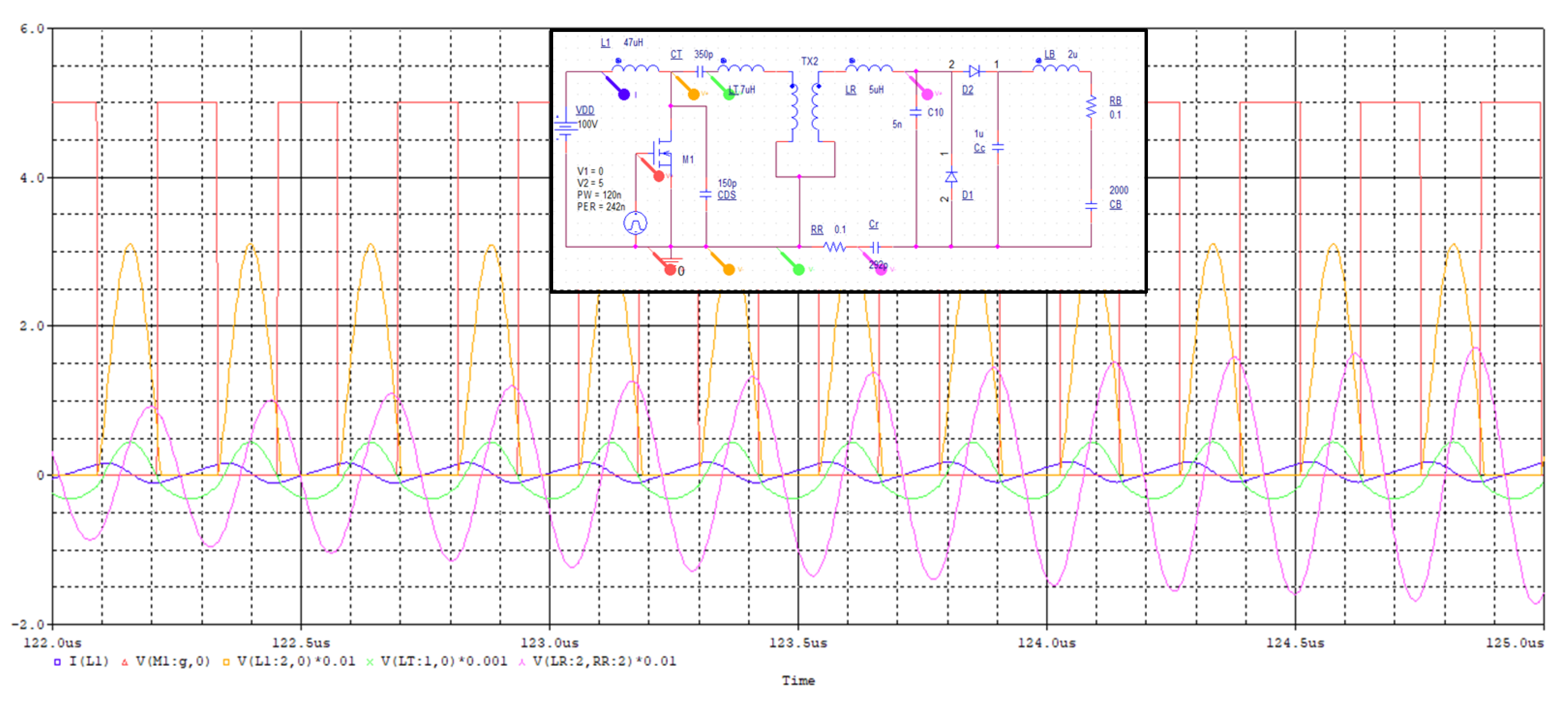
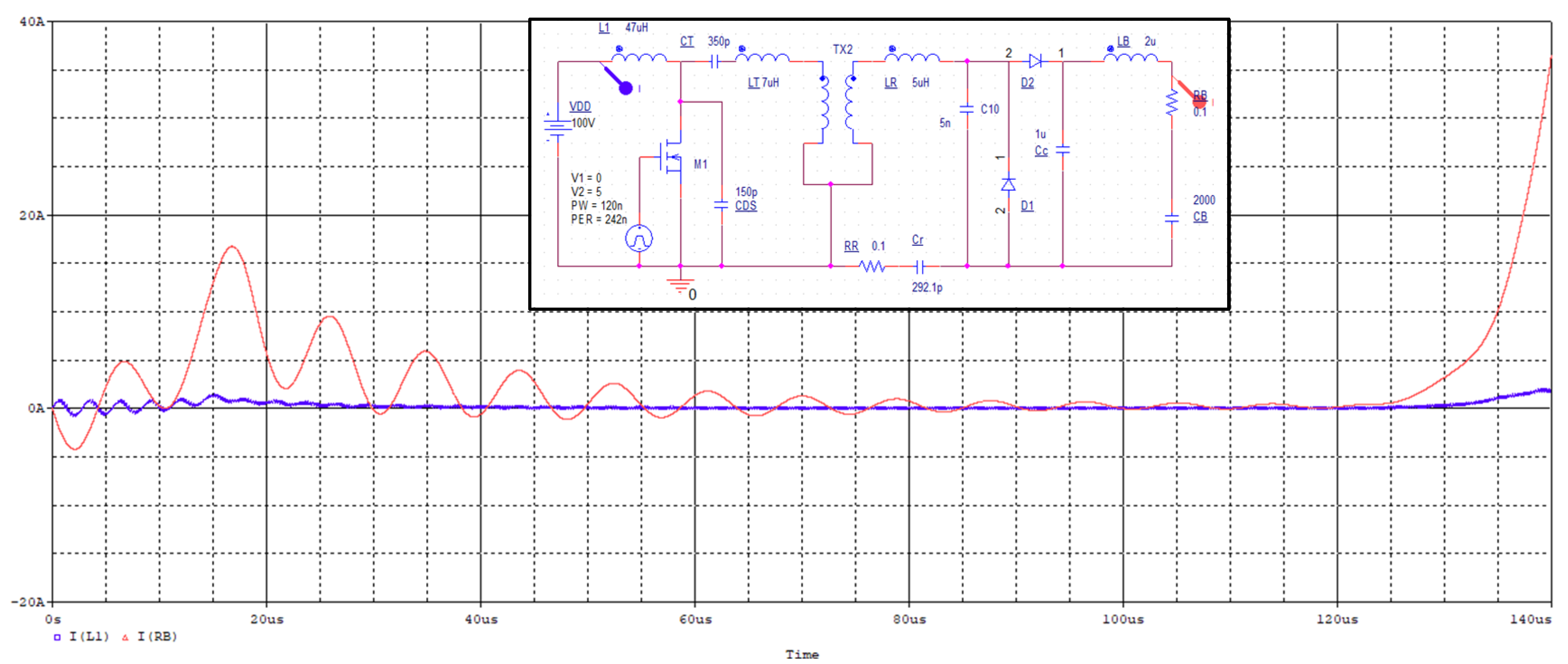
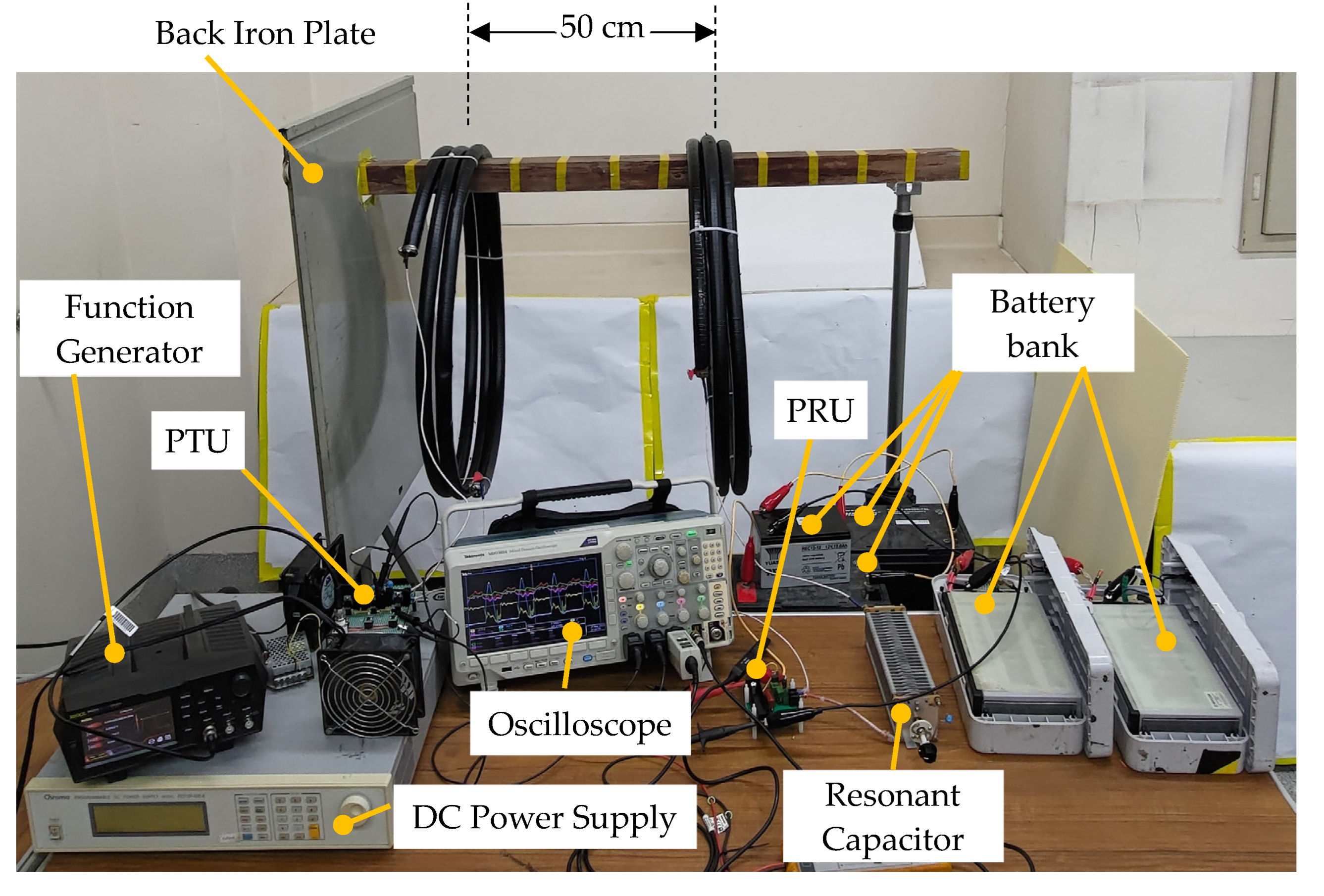
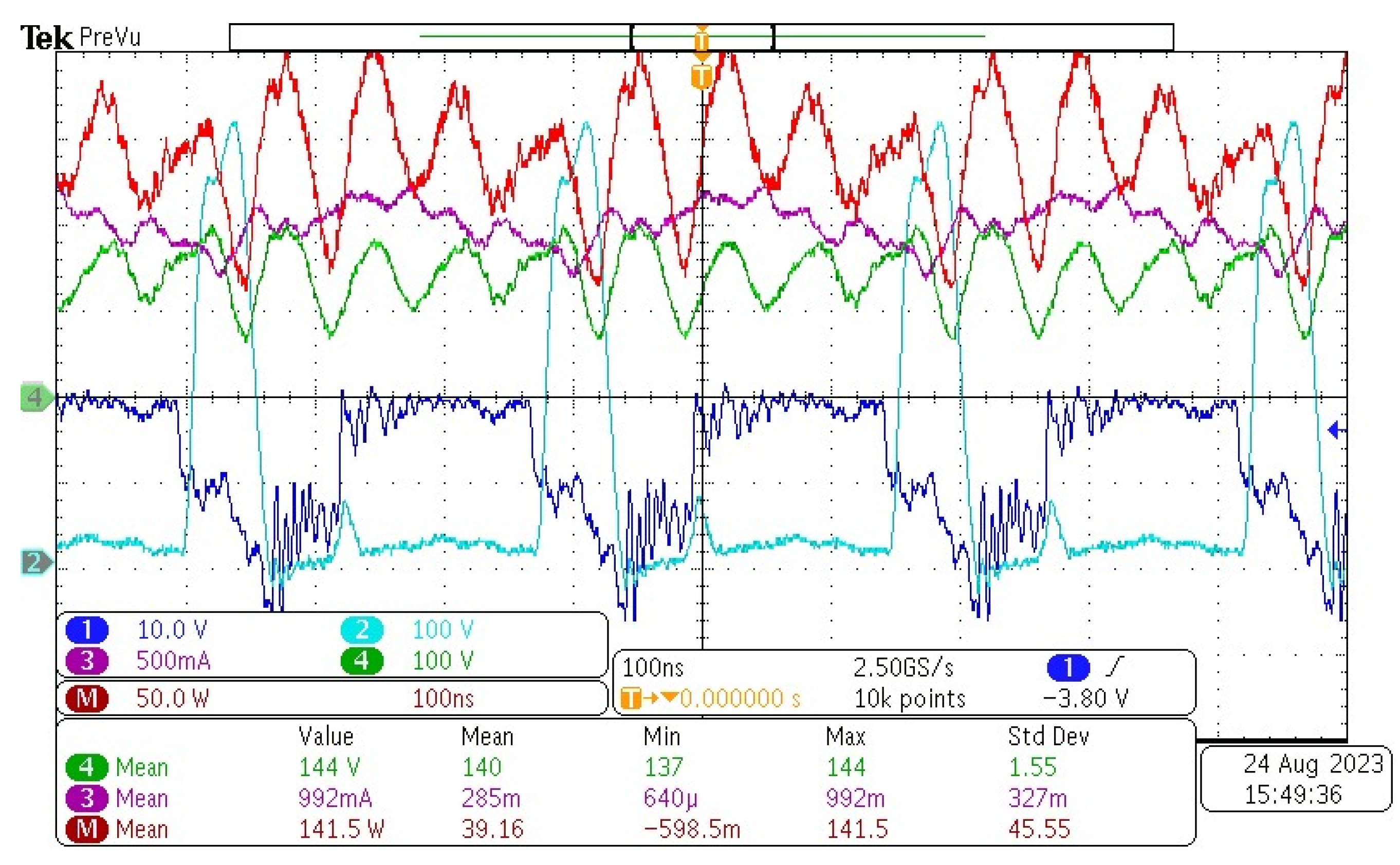
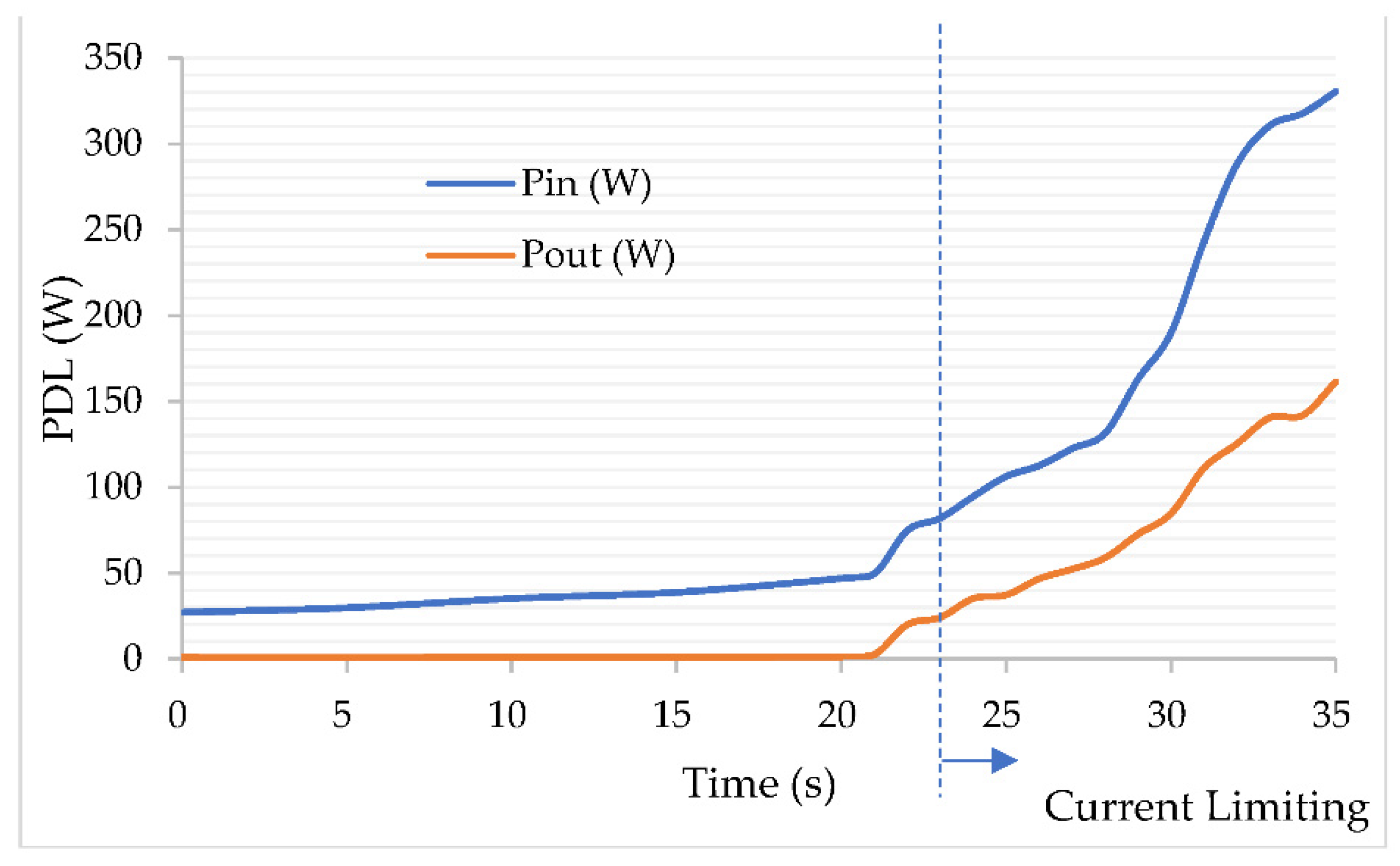
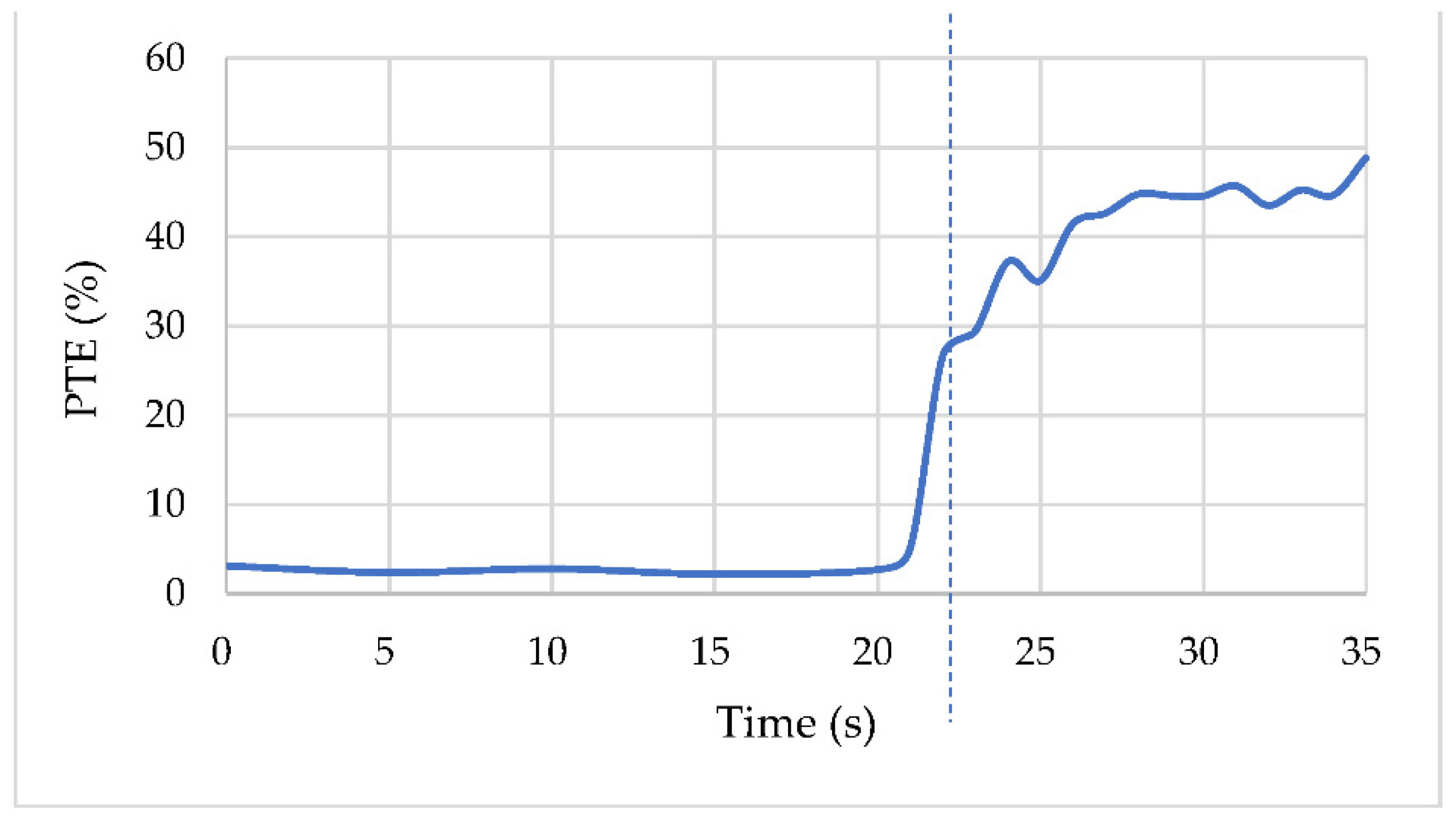
| Symbol | Description | Unit | VDS | |
|---|---|---|---|---|
| 0V | 600V | |||
| Coss | Output capacitance | pF | 31 | 17 |
| Ciss | Input capacitance | pF | 46 | 31 |
| Crss | Feedback capacitance | pF | 23 | 8 |
| Vth | Gate turn on voltage | V | −9 | |
| VGS | Maximum | V | 10 ~ −30 | |
| RDS,on | On resistance | m | 900 | |
| VBD | Breakdown voltage | V | 600 | |
| iD,cont. | Continuous drain current | A | 3 | |
| Item | Description | Unit | Value |
|---|---|---|---|
| PTU coil resistance | Ohm | 0.1 | |
| PRU coil resistance | Ohm | 0.1 | |
| Battery resistance | Ohm | 0.1 | |
| Leakage inductance of WPT transformer | uH | 5 | |
| Magnetization inductance of WPT transformer | uH | 0.1 | |
| Band pass filter inductance | uH | 2 | |
| High voltage, fast recovery diode; SiC | STPSC406D | ||
| PRU resonance capacitance | pF | 290 | |
| PRU AC voltage divider capacitance | nF | 5 | |
| Battery capacitance | F | 2000 | |
| PRU AC-DC output capacitance | uF | 1 | |
| PRU stabilization capacitance | mF | 1 | |
| k | Magnetic Coupling Coefficient | 1 | |
| Battery voltage | V | 4 | |
Disclaimer/Publisher’s Note: The statements, opinions and data contained in all publications are solely those of the individual author(s) and contributor(s) and not of MDPI and/or the editor(s). MDPI and/or the editor(s) disclaim responsibility for any injury to people or property resulting from any ideas, methods, instructions or products referred to in the content. |
© 2024 by the authors. Licensee MDPI, Basel, Switzerland. This article is an open access article distributed under the terms and conditions of the Creative Commons Attribution (CC BY) license (https://creativecommons.org/licenses/by/4.0/).





